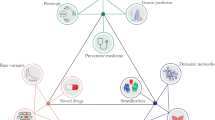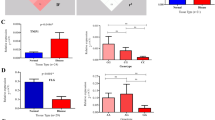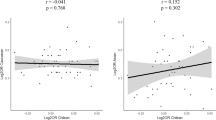Abstract
Using a multi-tiered, case–control association design, scanning 25 215 gene-centric SNPs, we previously identified two psoriasis susceptibility genes: IL12B and IL23R. These results have recently been confirmed. To better characterize the IL23R psoriasis-association, we used a fine mapping strategy to identify 59 additional IL23R-linked SNPs, which were genotyped in our three independent, white North American sample sets (>2800 individuals in toto). A sliding window of haplotype association demonstrates colocalization of psoriasis susceptibility effects within the boundaries of IL23R across all sample sets, thereby decreasing the likelihood that neighboring genes, particularly IL12RB2, are driving the association at this region. Additional haplotype work identified two 5-SNP haplotypes with strong protective effects, consistent across our three sample sets (ORcommon=0.67; Pcomb=4.32E-07). Importantly, heterogeneity of effect was extremely low between sample sets for these haplotypes (PHet=0.961). Together, these protective haplotypes attain a frequency of 16% in controls, declining to 11% in cases. The characterization of association patterns within IL23R to specific predisposing/protective variants will play an important role in the elucidation of psoriasis etiology and other related phenotypes. Further, this work is essential to lay the foundation for the role of IL23R genetics in response to pharmaceutical therapy and dosage.
This is a preview of subscription content, access via your institution
Access options
Subscribe to this journal
Receive 6 digital issues and online access to articles
$119.00 per year
only $19.83 per issue
Buy this article
- Purchase on Springer Link
- Instant access to full article PDF
Prices may be subject to local taxes which are calculated during checkout



Similar content being viewed by others
References
Chan JR, Blumenschein W, Murphy E, Diveu C, Wiekowski M, Abbondanzo S et al. IL-23 stimulates epidermal hyperplasia via TNF and IL-20R2-dependent mechanisms with implications for psoriasis pathogenesis. J Exp Med 2006; 203: 2577–2587.
Neimann AL, Porter SB, Gelfand JM . The epidemiology of psoriasis. Expert Rev Dermatol 2006; 1: 63–75.
Kremers HM, McEvoy MT, Dann FJ, Gabriel SE . Heart disease in psoriasis. J Am Acad Dermatol 2007; 57: 347–354.
Griffiths CEM, Barker JN . Pathogenesis and clinical features of psoriasis. The Lancet 2007; 370: 263–271.
Farber EM, Nall ML, Watson W . Natural history of psoriasis in 61 twin pairs. Arch Dermatol 1974; 109: 207–211.
Nair RP, Stuart PE, Nistor I, Hiremagalore R, Chia NV, Jenisch S et al. Sequence and haplotype analysis supports HLA-C as the psoriasis susceptibility 1 gene. Am J Hum Genet 2006; 78: 827–851.
Helms C, Cao L, Krueger JG, Wijsman EM, Chamain F, Gordon D et al. A putative RUNX1 binding site variant between SLC9A3R1 and NAT9 is associated with susceptibility to psoriasis. Nat Genet 2003; 35: 349–356.
Capon F, Helms C, Veal CD, Tillman D, Burden AD, Barker JN et al. Genetic analysis of PSORS2 markers in a UK dataset supports the association between RAPTOR SNPs and familial psoriasis. J Med Genet 2004; 41: 459–460.
Stewart P, Nair RP, Abecasis GR, Nistor I, Hiremagalore R, Chia NV et al. Analysis of RUNX1 binding site and RAPTOR polymorphisms in psoriasis: no evidence for association despite adequate power and evidence for linkage. J Med Genet 2006; 43: 12–17.
Tsunemi Y, Saeki H, Nakamura K, Sekiya T, Hirai K, Fujita H et al. Interleukin-12 p40 gene (IL12B) 3′-untranslated region polymorphism is associated with susceptibility to atopic dermatitis and psoriasis vulgaris. J Dermatol Sci 2002; 302: 161–166.
Cargill M, Schrodi SJ, Chang M, Garcia VE, Brandon R, Callis KP et al. A large-scale genetic association study confirms IL12B and leads to the identification of IL23R as psoriasis-risk genes. Am J Hum Genet 2007; 80: 273–290.
Capon F, DiMeglio P, Szaub J, Prescott NJ, Dunster C, Baumber L et al. Sequence variants in the genes for the interleukin-23 receptor (IL23R) and its ligand (IL12B) confer protection against psoriasis. Hum Genet 2007; 122: 201–206.
Smith RL, Warren RB, Eyre S, Ho P, Ke X, Young HS et al. Polymorphisms in the IL-12beta and IL-23R genes are associated with psoriasis of early onset in a UK cohort. J Invest Dermatol 2007; 128: 1325–1327.
Nair RP, Ruether A, Stuart PE, Jenisch S, Tejasvi T, Hiremagalore R et al. Polymorphisms of the IL12B and IL23R genes are associated with psoriasis. J Invest Dermatol 2008; 128: 1653–1661.
Liu Y, Helms C, Liao W, Zaba LC, Duan S, Gardner J et al. A genome-wide association study of psoriasis and psoriatic arthritis identifies new disease loci. PLoS Genet 2008; 28: e1000041.
Duerr RH, Taylor KD, Brant SR, Rioux JD, Silverberg MS, Daly MJ et al. A genome-wide association study identifies IL23R as an inflammatory bowel disease gene. Science 2006; 314: 1461–1463.
Libioulle C, Louis E, Hansoul S, Sandor C, Farnir F, Franchimont D et al. Novel Crohn disease locus identified by genome-wide association maps to a gene desert on 5p13.1 and modulates expression of PTGER4. PLoS Genet 2007; 3: e58.
Wellcome Trust Case Control Consortium. Genome-wide association study of 14 000 cases of seven common diseases and 3000 shared controls. Nature 2007; 447: 661–678.
Parkes M, Barrett JC, Prescott NJ, Tremelling M, Anderson CA, Fisher SA et al. Sequence variants in the autophagy gene IRGM and multiple other replicating loci contribute to Crohn's disease susceptibility. Nat Genet 2007; 39: 830–832.
Raelson JV, Little RD, Ruether A, Fournier H, Paquin B, Van Eerdewegh P et al. Genome-wide association study for Crohn's disease in the Quebec founder population identifies multiple validated disease loci. Proc Natl Acad Sci USA 2007; 104: 14747–14752.
Tremelling M, Cummings F, Fisher SA, Mansfield J, Gwilliam R, Keniry A et al. IL23R variation determines susceptibility but not disease phenotype in inflammatory bowel disease. Gastroenterology 2007; 132: 1657–1664.
Van Limbergen J, Russell RK, Nimmo ER, Drummond HE, Smith L, Davies G et al. IL23R Arg381Gln is associated with childhood onset inflammatory bowel disease in Scotland. Gut 2007; 56: 1173–1174.
Dubinsky MC, Wang D, Picornell Y, Wrobel I, Katzir L, Quiros A et al. IL-23 receptor (IL-23R) gene protects against pediatric Crohn's disease. Inflamm Bowel Dis 2007; 13: 511–515.
Baldassano RN, Bradfield JP, Monos DS, Kim CE, Glessner JT, Casalunovo T et al. Association of variants of the interleukin-23 receptor gene with susceptibility to pediatric Crohn's disease. Clin Gastroenterol Hepatol 2007; 5: 972–976.
Wellcome Trust Case Control Consortium, Australo-Anglo-American Spondylitis Consortium (TASC), Burton PR, Clayton DG, Cardon LR, Craddock N, Deloukas P, Duncanson A et al. Association scan of 14 500 nonsynonymous SNPs in four diseases identifies autoimmunity variants. Nat Genet 2007; 39: 1329–1337.
Rueda B, Orozco G, Raya E, Fernandez-Sueiro JL, Mulero J, Blanco FJ et al. The IL23R Arg381R non-synonymous polymorphism confers susceptibility to ankylosing spondylitis. Ann Rheum Dis 2008; e-pub ahead of print 16 January.
Huber AK, Jacobson EM, Jazdzewski K, Concepcion ES, Tomer Y . IL-23R is a major susceptibility gene for Graves' ophthalmopathy: the IL-23/Th17 axis extends to thyroid autoimmunity. J Clin Endocrinol Metab 2007; 93: 1077–1081.
Nunez C, Dema B, Cenit MC, Polanco I, Maluenda C, Arroyo R et al. IL23R: a susceptibility locus for celiac disease and multiple sclerosis? Genes Immun 2008; 9: 289–293.
Illes Z, Safrany E, Peterfalvi A, Magyari L, Farago B, Pozsonyi E et al. 3′UTR C2370A allele of the IL-23 receptor gene is associated with relapsing-remitting multiple sclerosis. Neurosci Lett 2008; 431: 36–38.
Roos IM, Kockum I, Hillert J . The interleukin 23 receptor gene in multiple sclerosis: a case-control study. J Neuroimmunol 2008; 194: 173–180.
Begovich AB, Chang M, Caillier SJ, Lew D, Catanese JJ, Wang J et al. The autoimmune disease-associated IL12B and IL23R polymorphisms in multiple sclerosis. Hum Immunol 2007; 68: 934–937.
Zhang X-J, Yan K-L, Wang Z-M, Yang S, Zhang G-L, Fan X et al. Polymorphisms in interleukin-15 gene on chromosome 4q31.2 are associated with psoriasis vulgaris in Chinese population. J Invest Derm 2007; 127: 2544–2551.
Chang M, Li Y, Yan C, Duffin KPC, Matsunami N, Garcia VE et al. Variants in the 5q31 cytokine gene cluster are associated with psoriasis. Genes Immun 2007; 9: 176–181.
Clark AG . The role of haplotypes in candidate gene studies. Genet Epidemiol 2004; 27: 321–333.
International HapMap Consortium. A haplotype map of the human genome. Nature 2007; 437: 1299–1320.
Airoldi I, Di Carlo E, Cocco C, Sorrentino C, Fais F, Cilli M et al. Lack of il12rb2 signaling predisposes to spontaneous autoimmunity and malignancy. Blood 2005; 106: 3846–3853.
Lee E, Trepicchio WL, Oestreicher JL, Pittman D, Wang F, Chamian F et al. Increased expression of interleukin 23 p19 and p40 in lesional skin of patients with psoriasis vulgaris. J Exp Med 2004; 199: 125–130.
Chan JR, Blumenschein W, Murphy E, Diveu C, Wiekowski M, Abbondanzo S et al. IL-23 stimulates epidermal hyperplasia via TNF and IL-20R2-dependent mechanisms with implications for psoriasis pathogenesis. J Exp Med 2006; 203: 2577–2587.
Ghilardi N, Kljavin N, Chen Q, Lucas S, Gurney AL, de Sauvage FJ . Compromised humoral and delayed-type hypersensitivity responses in IL-23-deficient mice. J Immunol 2004; 172: 2827–2833.
Park H, Li Z, Yang XO, Chang SH, Nurieva R, Wang YH et al. A distinct lineage of CD4T cells regulates tissue inflammation by producing interleukin 17. Nat Immunol 2005; 6: 1133–1141.
Harrington LE, Hatton RD, Mangan PR, Turner H, Murphy TL, Murphy KM et al. Interleukin 17-producing CD4+ effector T cells develop via a lineage distinct from the T helper type 1 and 2 lineages. Nat Immunol 2005; 6: 1123–1132.
Veldhoen M, Hocking RJ, Atkins CJ, Locksley RM, Stockinger B . TGFβ in the context of an inflammatory cytokine milieu supports de novo differentiation of IL-17-producing T-cells. Immunity 2006; 24: 179–189.
Hue S, Ahern P, Buonocore S, Kullberg MC, Cua DJ, McKenzie BS et al. Interleukin-23 drives innate and T cell-mediated intestinal inflammation. J Exp Med 2006; 203: 2473–2483.
Kauffman CL, Aria N, Toichi E, McCormick TS, Cooper KD, Gottlieb AB et al. A phase I study evaluating the safety, pharmacokinetics, and clinical response of a human IL-12 p40 antibody in subjects with plaque psoriasis. J Invest Dermatol 2004; 123: 1037–1044.
Krueger GG, Langley RG, Leonardi C, Yeilding N, Guzzo C, Wang Y et al. A human interleukin-12/23 monoclonal antibody for the treatment of psoriasis. N Engl J Med 2007; 356: 580–592.
Mannon PJ, Fuss IJ, Mayer L, Elson CO, Sandborn WJ, Present D et al. Anti-interleukin-12 antibody for active Crohn's disease. N Engl J Med 2004; 351: 2069–2079.
Hu X, Schrodi SJ, Ross DA, Cargill M . Selecting tagging SNPs for association studies using power calculations from genotype data. Hum Hered 2004; 57: 156–170.
Weir BS . Genetic Data Analysis II: Methods for Discrete Population Genetic Data. Sinauer: Sunderland, MA, USA, 1996.
Sokal RR, Rohlf FJ . Biometry 3rd edn, W.H. Freeman and Company: USA, 1995.
Fisher RA . Statistical Methods for Research Workers, 12th edn, Oliver & Boyd: Edinburgh, 1954.
Mantel N, Haenszel W . Statistical aspects of the analysis of data from retrospective studies of disease. J Nat Cancer Inst 1959; 22: 719–748.
Excoffier L, Slatkin M . Maximum-likelihood estimation of molecular haplotype frequencies in a diploid population. Mol Biol Evol 1995; 12: 921–927.
Abecasis GR, Cookson WO . GOLD—graphical overview of linkage disequilibrium. Bioinformatics 2000; 16: 182–183.
Schaid DJ, Rowland CM, Tines DE, Jacobson RM, Poland GA . Score tests for association between traits and haplotypes when linkage phase is ambiguous. Am J Hum Genet 2002; 70: 425–434.
Yoo J, Seo B, Kim Y . SNPAnalyzer: a web-based integrated workbench for single-nucleotide polymorphism analysis. Nucleic Acids Res 2005; 33 (Web Server issue): W483–W488.
Li H . A permutation procedure for the haplotype method for identification of disease-predisposing variants. Ann Hum Genet 2001; 65: 189–196.
Acknowledgements
We are grateful to all the individuals with psoriasis and control subjects for participation in this study. We thank J Sninsky and T White for their comments on the paper, scientific advice and support. We also thank the members of the Celera High Throughput Lab and Computational Biology Group, S Prescott, M Paul, A Lindell, everyone at Lineagen, E Beasley, L McAllister and M Cargill for key help with this project. This study was supported in part by a Public Health Services research grant to the Huntsman General Clinical Research Center at the University of Utah, by National Center for Research Resources Grant M01-RR00064 and by generous gifts from the WM Keck Foundation and from the George S and Delores Dore Eccles Foundation. Finally, we note that as current employees of Celera, VE Garcia, M Chang, N Bui, JJ Catanese, Y Li, R Brandon, AB Begovich and SJ Schrodi may hold stock or stock options in Celera.
Author information
Authors and Affiliations
Corresponding author
Additional information
Supplementary Information accompanies the paper on Genes and Immunity website (http://www.nature.com/gene)
Supplementary information
Rights and permissions
About this article
Cite this article
Garcia, V., Chang, M., Brandon, R. et al. Detailed genetic characterization of the interleukin-23 receptor in psoriasis. Genes Immun 9, 546–555 (2008). https://doi.org/10.1038/gene.2008.55
Received:
Revised:
Accepted:
Published:
Issue Date:
DOI: https://doi.org/10.1038/gene.2008.55
This article is cited by
-
Extra-adrenal glucocorticoid synthesis at epithelial barriers
Genes & Immunity (2019)
-
The Role of Pharmacogenetics in Chronic Plaque Psoriasis: Update of the Literature
Molecular Diagnosis & Therapy (2017)
-
Gene polymorphisms that can predict response to anti-TNF therapy in patients with psoriasis and related autoimmune diseases
The Pharmacogenomics Journal (2013)
-
Paradoxical inflammation induced by anti-TNF agents in patients with IBD
Nature Reviews Gastroenterology & Hepatology (2012)
-
Association of IL23R polymorphisms with psoriasis and psoriatic arthritis: a meta-analysis
Inflammation Research (2012)



